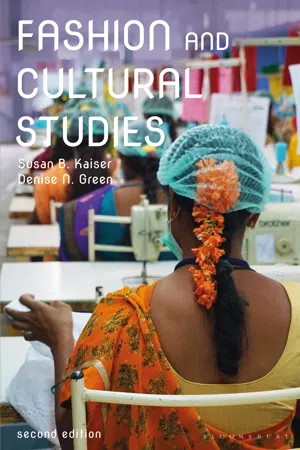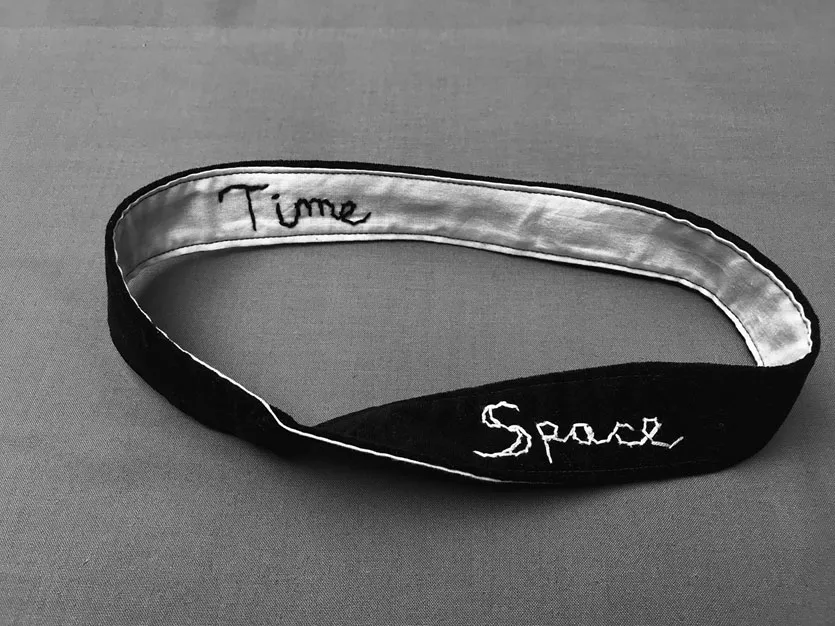CHAPTER 1 Fashion Studies and Cultural Studies
Fashion is not a thing or an essence. Rather, it is a social and embodied process of negotiation and navigation through the murky and yet-hopeful waters of what is to come. Fashion involves becoming collectively with others. When and where does this happen, and who gets to decide what constitutes fashion? It turns out that this is neither a smooth nor a seamless process: multiple perspectives compete and contribute based upon diverse cultural histories, vested interests, and hopes and dreams. The process of fashion is inevitably linked to making and sustaining, as well as resisting and dismantling, power.
Fashion materializes as various bodies move through time and space. Time and space are both abstract concepts and contexts: the process of deciphering and expressing a sense of who we are (becoming) happens in tandem with deciphering and expressing when and where we are. This is not as simple as it may sound; the process of expressing this “who, when, and where” is an ongoing challenge of traversing multiple ambiguities and contradictions associated with the following:
• being an individual fashion subject in the context of a global economy, in which fashion flows through complex, transnational dynamics that are at once visual and material, virtual and tangible, local and global;
• simultaneously referencing elements and issues of the past with those of the present and emerging future;
• concurrently and intersectionally embodying and fashioning gender, race, ethnicity, religion, sexuality, class, nation, age/generation, body size, dis/ability, and other “subject positions” that are themselves shifting through complex power relations;
• desiring at once to fit in with one’s social world and to express some degree of uniqueness within that world; and
• an ever-changing interplay between freedoms and constraints, which refers to the ongoing structure–agency debate in the social sciences and humanities.
Fashion is never finished, and it crosses all kinds of boundaries. It is ongoing and changes with each person’s visual and material interpretations of who they are becoming and how this becoming connects with others’ experiences within time and place. Fashion is also about producing clothes and appearances, working through ideas, negotiating subject positions (e.g., gender, ethnicity, class), and navigating power relations. It involves mixing, borrowing, belonging, and changing. But it is also about matching, creating, differentiating, and continuing. It is a complex process that entangles multiple perspectives and approaches. The study of fashion, as well, requires integrative and imaginative ways of knowing. Throughout this book, we draw on fashion studies and feminist cultural studies concepts, metaphors, and models that challenge simple oppositional (either/or), linear (straight), and essentialist (predetermined, fixed, bounded) ways of thinking about and with fashion.
Oppositional thinking produces false dichotomies by oversimplifying differences and limiting options for the analysis of connections and entanglements. Framing fashion in either/or terms also prevents understandings of what the feminist geographer Doreen Massey called “power geometries”: for example, the complex interplay between time and space (Massey 1993). In other words, power is multidimensional, not just oppositional. Fashion helps us to contemplate power in ways that multiply, complicate, and intersect beyond (and in the space in-between) oppositional thinking.
Studying fashion is a both/and, rather than an either/or, activity. Fashion thrives upon contradictions (conflicting truth claims) and ambivalences (conflicting emotions); hence, it requires both/and ways of knowing and feeling. Combining fashion and feminist cultural studies perspectives encourages thinking that disrupts, blurs, and transcends binary (either/or) oppositions. One of the fundamental binary oppositions feminist theorists have critiqued is masculinity versus femininity, because this either/or way of thinking has historically limited options for considering gender in a more expansive and inclusive sense, perpetuated power-related hierarchies, and prioritized white masculinity as the dominant way of being in the world. In the realm of modern, white, Western fashion, as we will see, this has meant that there has been a dominant myth that men are not supposed to care too much about how they look. Their power comes from being “unmarked” (Phelan 1993) as contrasted with women, who assume the “masque” of femininity (Tseëlon 1995) and hence become more “marked” as the “other,” according to the mythical binary opposition. This myth, which becomes normalized through media representations and social interactions, reinforces the idea that dominant masculinity is about gazing at women, while dominant femininity is about being gazed at (Berger 1972). Disrupting this binary, essentialist way of thinking about gender alone, Black feminist theorists such as Kimberlé Crenshaw (1989), bell hooks (2000a), and Patricia Hill Collins (2019) have emphasized the ways in which the intersectionalities between gender and race have historically disadvantaged African American women, who at once find themselves in multiple and intersecting systems of oppression.
Gender (considered in more depth in Chapter 7) is not the only problematic binary opposition or dualism that has limited thinking about fashion, however. Indeed, until recent decades, the study of fashion has been stifled by the either/or thinking associated with modern Western thought:
• changing fashion versus “fixed” dress
• modern fashion versus traditional costume
• Western dress versus “the rest”
• the future versus the past
• time versus space
• structure versus agency
• masculinity versus femininity
• white versus Black
• straight versus gay
• cisgender versus transgender
• unmarked versus marked
• dressing to belong versus dressing to differentiate
• mainstream consumer fashion versus alternative street style
• consumption versus production, and so on.
In each of these cases, the first term gets prioritized over the second and often becomes normalized, and herein lies the problem: power becomes constructed in simplistic and uncritical terms. Obscured by these constructions are the overlapping realities, the contradictions, the third terms (e.g., bisexuality, genderfluidity) or other multiple possibilities that are in-between or outside of these binaries, and the subtle, subversive ways in which power operates in everyday life. We always need to be on the lookout for additional terms, beyond two, and to foster a better understanding of the space in-between and around the two. As we will see throughout this book, the pairs of terms above would benefit from further terms or a rethinking of their relationality as both/and (or ideally, when possible, both/and/and [von Busch 2020]) rather than either/or. Some of the terms used above, such as fixed and the rest, should probably be dispensed with altogether.
However, sometimes there are two terms that need to be looked at together in order to get a sense of a both/and whole. Among the binary oppositional terms listed above, four stand out in this way: time and space (considered in Chapter 10); and unmarked and marked or, better, processes of unmarking and marking; structure and agency; and dressing to belong and dressing to differentiate. There are some terms that cannot be easily disentangled as a pair because we experience them simultaneously (in both/and ways) through everyday embodied experience.
How can we visualize “twos” as interdependent or convergent, rather than oppositional? The cultural theorist Noam Chomsky (1986) talks about convergence as a kind of mathematical mystery, using the metaphor of the Möbius strip (see Figure 1.1). In the nineteenth century, the German mathematician Augustus Möbius found that a strip or ribbon that is two-sided can be experienced as one continuous surface. There is a kind of convergence that results when there is no inside, no outside, no beginning, and no end. When the ends of a strip of fabric or ribbon are attached and the resulting loop is slightly twisted, it becomes possible to move along a path without leaving a side or crossing an edge. Normally, fashion is all about crossings, intersections, and entanglements, but as the Möbius strip reminds us metaphorically, it is also about convergence and connection. As individuals fashion their bodies (see Entwistle 2000), for example, they experience this process as a convergence of time and space. We cannot separate when we are from where we are in the course of everyday experience.
The field of fashion studies requires multiple metaphors and models to think with at once; part of the task of fashion studies is to mix metaphors in ways that enable critical and creative understandings of the pleasures and power relations associated with how we dress or style our appearances in everyday life. We need multiple metaphors or models (Kaiser 2008) to think about the complex “hows” and “whys” of body fashionings.
Textiles are both material and symbolic; hence, they hold a lot of potential for understanding both physical and sociocultural qualities. Given the flexible, malleable nature of two-dimensional fabrics and their complex production, textile metaphors abound. One of these involves fabric’s ability to fold: to bend, to wrinkle, to twist, to drape. Cultural theorists such as Walter Benjamin (1892–1940) and Gilles Deleuze (1925–1995) found “the fold” to be a productive metaphor for issues of time, space, and subjectivity (being and becoming). For example, Benjamin observed that the fold represents the ways in which fashion “contains the ghost of the past in the present via the recycling of past styles”; it fosters memories such as those of a child holding onto the folds of their mother’s skirt (Benjamin in Geczy and Karaminas 2016: 88–9). Benjamin saw the fold as a model that challenges any modern idea of linearity in fashion history. Fashion, that is, has a nonlinear or even antilinear (Evans and Vaccari 2020: 21) way with time: it simultaneously evokes memories of the “past present,” on the one hand, and an “anticipated future,” on the other (Geczy and Karaminas 2016: 88).
Gilles Deleuze used the metaphor of the fold in a slightly different way, but one that also highlights both/and ways of knowing, rather than thinking in terms of either/or oppositions. Folding and unfolding, in Deleuze’s view, are not opposite essences but rather part of ongoing processes of infinite possibility or becoming (Deleuze and Strauss 1991: 227, 243). These ongoing processes represent the agency of action, as “philosophy finds in the fold the expression of a continuous and vital force of being and becoming” (Conley 2005: 180). As fashion theorist Anneke Smelik (2014) puts it:
Smelik (2014) goes on to say that the concept of the fold “demolishes binary oppositions” (38); this is a key idea in feminist philosophical thought (beginning with the binary opposition between masculinity and femininity), in addition to Deleuze’s formulation. And it applies in folds to fashion studies. Materially, the fold can take on a variety of forms in fashion, including pleats, ruffles, bows, subtle twists, knots, and so on. Throughout this book, a variety of metaphors are used alongside the textile metaphors and the Möbius strip (and its convergence of two concepts) in order to capture the complexity of flows, intersections, and entanglements among multiple concepts (e.g., identities, materials, and practices).
In Chapter 10, we come back to the theme of time and space—taken together and intimately connected. For now, it is helpful to reflect on the ways in which,...

